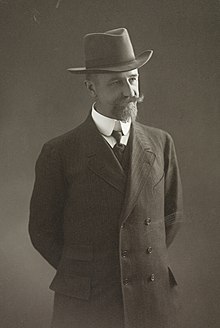Maurice Lugeon
Maurice Lugeon | |
|---|---|
 Maurice Lugeon | |
| Born | 10 July 1870 |
| Died | 23 October 1953 (aged 83) |
| Nationality | |
| Known for | nappe tectonics |
| Awards |
|
| Scientific career | |
| Fields | geology |
Maurice Lugeon FRS(For)[1] HFRSE FGS (10 July 1870 – 23 October 1953) was a Swiss geologist, and the pioneer of nappe tectonics. He was a pupil of Eugène Renevier. Named for Maurice Lugeon, the lugeon is a measure of transmissivity in rocks, determined by pressurized injection of water through a bore hole driven through the rock. One Lugeon (Lu) is equivalent to one litre of water per minute, injected into 1 metre of borehole at an injection pressure of 10 atmospheres.
Life[edit]
He was born in Poissy near Paris on 10 July 1870. His family moved to Lausanne in Switzerland in 1876. From the age of 15 he showed a strong interest in geology.[2]
He spent most of his academic life at the University of Lausanne becoming Professor of Geology in 1906. He retired in 1940.[3] He became an expert on dam locations and was consulted widely on this.
He died in Lausanne in Switzerland on 23 October 1953.
Publications[edit]
- Dams and Geology (1933)
Family[edit]
He was married to Ida Welti.
References[edit]
- ^ a b Bailey, E. B. (1954). "Maurice Lugeon. 1870–1953". Obituary Notices of Fellows of the Royal Society. 9 (1): 164–173. doi:10.1098/rsbm.1954.0012. JSTOR 769205.
- ^ "Maurice Lugeon | Swiss geologist".
- ^ Biographical Index of Former Fellows of the Royal Society of Edinburgh 1783–2002 (PDF). The Royal Society of Edinburgh. July 2006. ISBN 0-902-198-84-X. Archived from the original (PDF) on 2016-03-04. Retrieved 2017-06-02.
External links[edit]
You can help expand this article with text translated from the corresponding article in French. (June 2013) Click [show] for important translation instructions.
|
